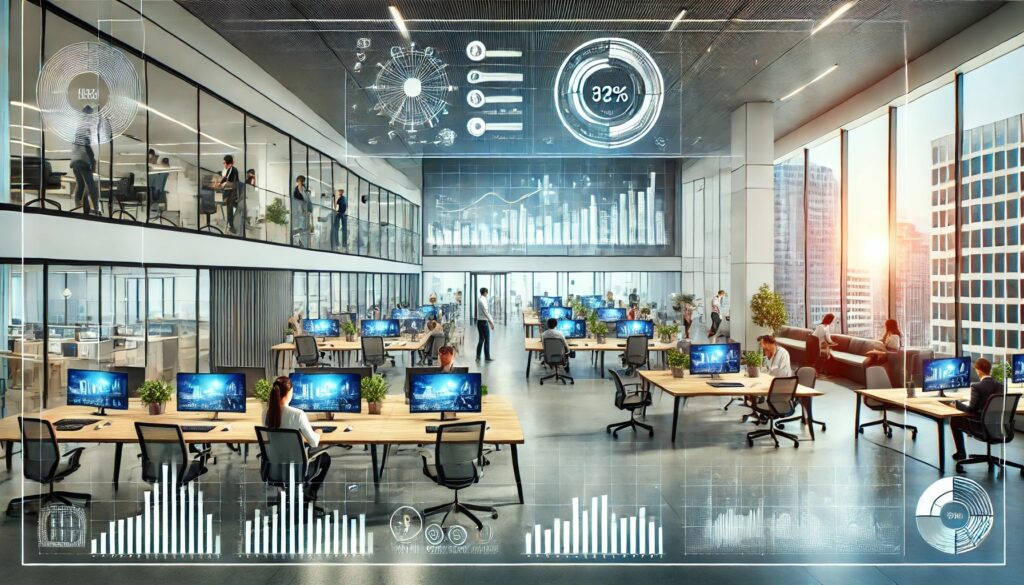Read a “corporate client’s perspective” about the startling results from a four-week installation of occupancy sensors and what they did next. This case study is compiled from our experience of working with more than 100 corporations worldwide, helping them to measure, evaluate and manage their office space use.
In an era where agile and flexible working models are becoming the norm, understanding how office spaces are actually utilised has never been more crucial. We recently partnered with Abintra to deploy their state-of-the-art occupancy sensors and software technology throughout our workplace, and the results were nothing short of shocking!
The Rise of Agile and Flexible Working
Agile and flexible working have transformed the corporate landscape on both sides of the Atlantic. This shift has brought about significant changes in how office spaces are designed and used. Traditional static office layouts are being replaced by dynamic environments that cater to a variety of working styles. According to a recent study, 83% of companies in North America and 77% in Europe have adopted some form of flexible working policy.
The Power of Abintra Technology
Abintra’s technology offers unparalleled insights into office space utilisation. By deploying their advanced occupancy sensors, we were able to gather real-time data on how every corner of our office was being used. These sensors collect data on foot traffic, workstation occupancy, and meeting room usage, providing a comprehensive picture of space utilisation.
Shocking Results from Our Survey
Here are some of the most surprising findings from our survey:
- Underutilised Workstations: On average, only 45% of our workstations were occupied at any given time. This means more than half of our desks were vacant, highlighting a significant inefficiency in our space allocation.
- Meeting Room Mismanagement: We discovered that while our meeting rooms were booked 70% of the time, they were only occupied for 30% of the scheduled time. This discrepancy indicates a massive overestimation of meeting room needs and points to the potential for optimising booking systems.
- Peak and Off-Peak Times: The data revealed distinct peaks and troughs in office usage. Peak times occurred between 10 AM and 2 PM, with occupancy rates soaring to 85%. Conversely, early mornings and late afternoons saw occupancy rates plummet to below 30%.
- Remote Work Impact: The rise of remote work has drastically altered office dynamics. Our survey showed that remote work days contributed to a 20% reduction in overall office occupancy. This trend is expected to continue, with 60% of employees indicating a preference for remote work at least two days a week.
Implications for Office Design and Management
The insights provided by Abintra have significant implications for how we design and manage our office spaces:
- Right-Sizing Office Space: With more than half of our desks consistently vacant, there’s a clear opportunity to reduce our real estate footprint and create more collaborative and flexible working areas.
- Optimising Meeting Spaces: By addressing the overbooking of meeting rooms, we can create more efficient scheduling systems and potentially repurpose underused spaces for other functions.
- Enhanced Employee Experience: Understanding peak usage times allows us to better support our employees by ensuring critical resources are available when needed and creating a more balanced and productive work environment.
A Global Perspective
Our findings are consistent with global trends. In the UK, a survey found that 40% of office space is underutilised on any given day, while in the US, this figure stands at 35%. These statistics highlight a widespread issue that businesses worldwide need to address.
Conclusion
Partnering with Abintra has provided us with eye-opening insights into how our office space is truly being used. The data has empowered us to make informed decisions that will enhance efficiency, reduce costs, and improve the overall employee experience. As the workplace continues to evolve, leveraging technology like Abintra’s occupancy sensors will be essential for staying ahead of the curve.
If you’re looking to transform your office space and embrace the future of work, consider how occupancy sensors and data analytics can provide the insights you need. The results might just shock you too.
